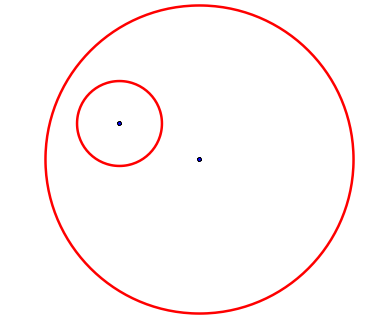
Roxanne Kerry

Roxanne
Kerry
For my seventh writeup, I am investigating tangent circles. Rather than go with the case that was presented in the beginning of the exploration, I decided to go with a slight variation. I wanted to take any two circles, and construct a circle that was tangent to both of these and containing the smaller circle. Here is the basic problem setup:

As you can see there are two circles, with the blue points representing their centers. I want to find a way to construct a circle tangent to both of the given circles, containing the smaller red circle. My initial intuition was to take the midpoint of the segment created by the centers of the original two triangles and let that be the center of my hypothesized tangent circle, but I found out quickly that this will not give you the tangent circle you are looking for, and in particular, will not even give you a tangent circle! Upon closer inspection, I found that the radius of my supposed “tangent” circle was smaller than the radius of the smaller given circle. Thus it makes sense why this could not create the tangent circle I am looking for. For this to have been the case, the radius would have to be larger than the radius of the smaller circle. Furthermore, if P is going to be the point of tangency, it can be no point within the circle, since the center of the circle, by definition, is the furthest distance away from the points on the circle.
So we must look for another approach. I knew that finding a tangent circle to these two given circles must have something to do with their centers and radii. Then, out of frustration, I just constructed a line through the centers of the two circles, and the solution came to me. Rather than taking the midpoint of the segment created by the centers of the circles, I marked off the points where the line going through the centers intersected the circles, and took the midpoint of the segment created by those two points. This, I hypothesized, should be the center of the circle tangent to both given circles. After construction of the circle with radius of either of the endpoints of the segment and center of the center I just found, this is the resulting tangent circle:

So
here we have it! The blue circle is the circle tangent to the two red
circles encircling the smaller red circle. Changing the radius of
the circles in GSP shows that this will work for any case in which
the smaller circle lies inside of the larger circle. It will even
work when the two red circles are no longer tangent; the blue circle
tangent to both red circles will encircle both of the original red
circles, as shown below:
